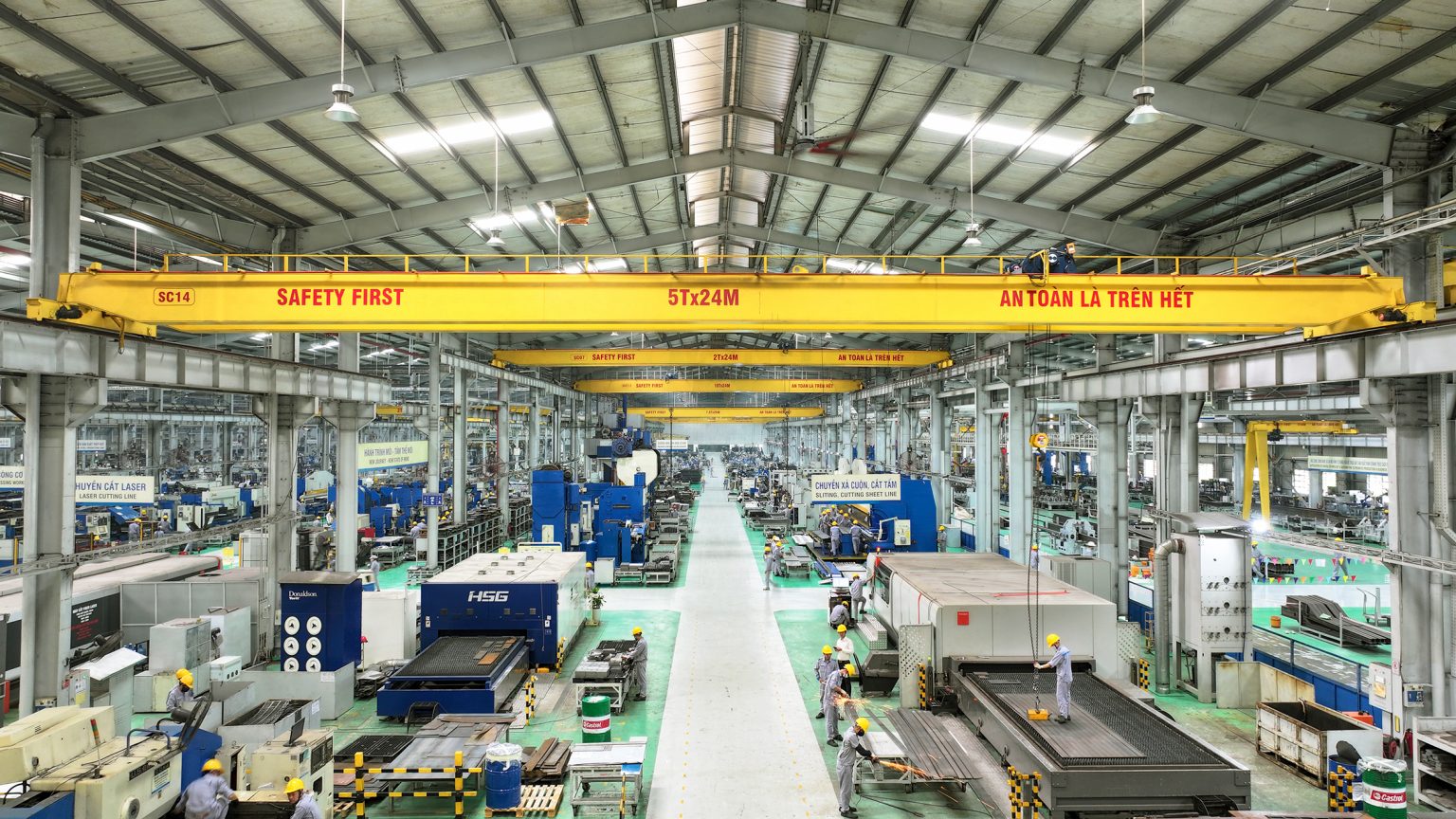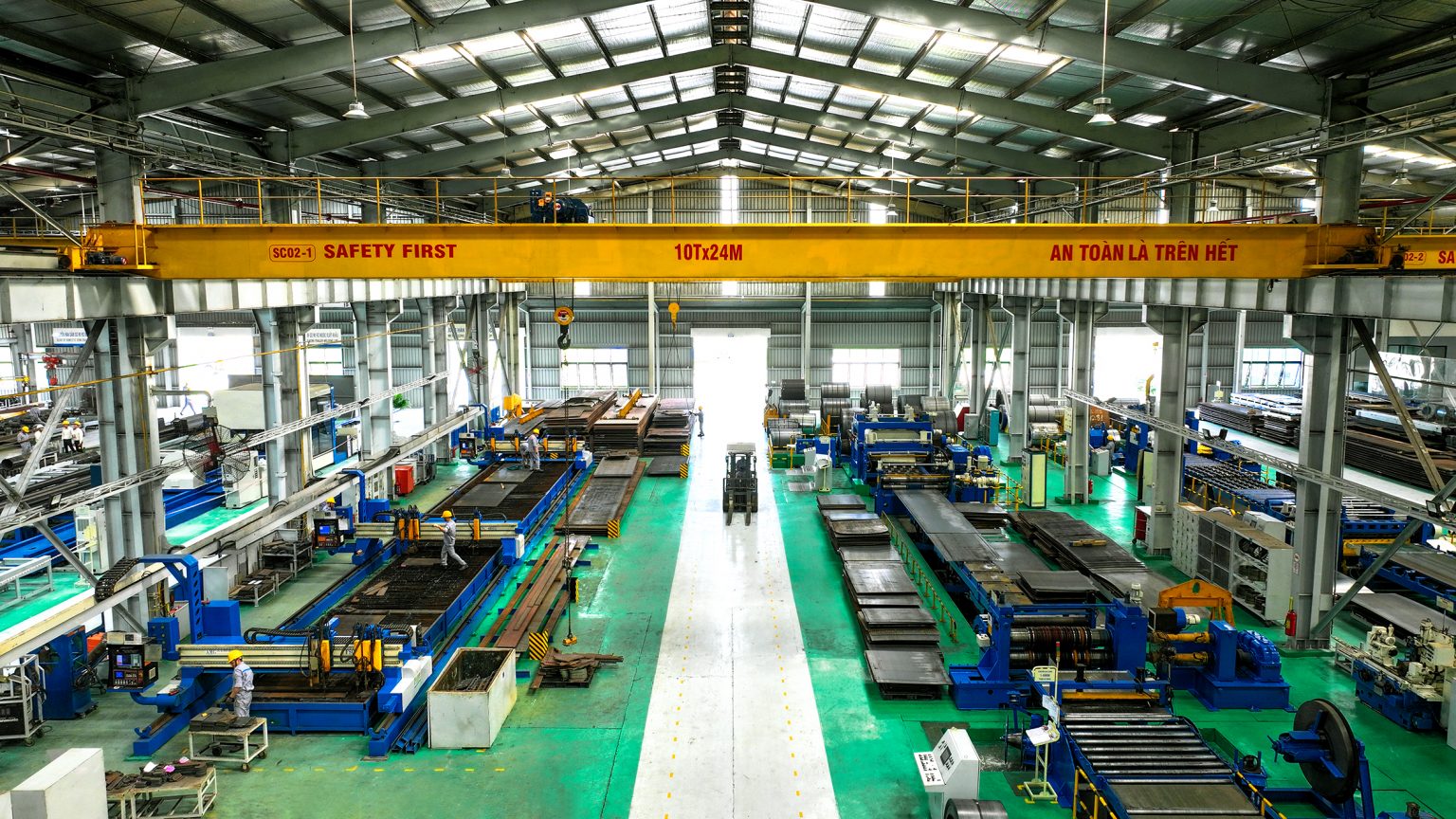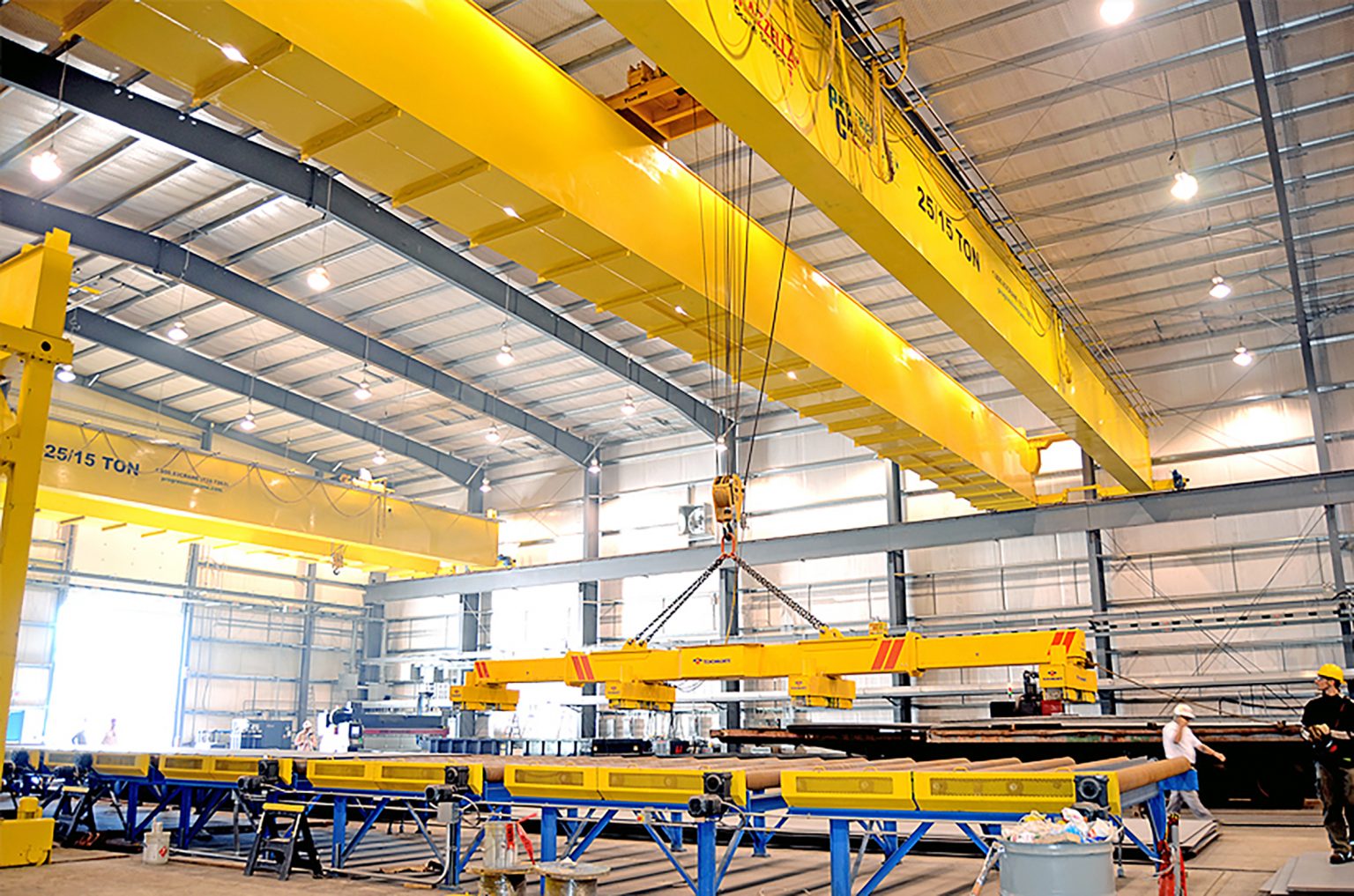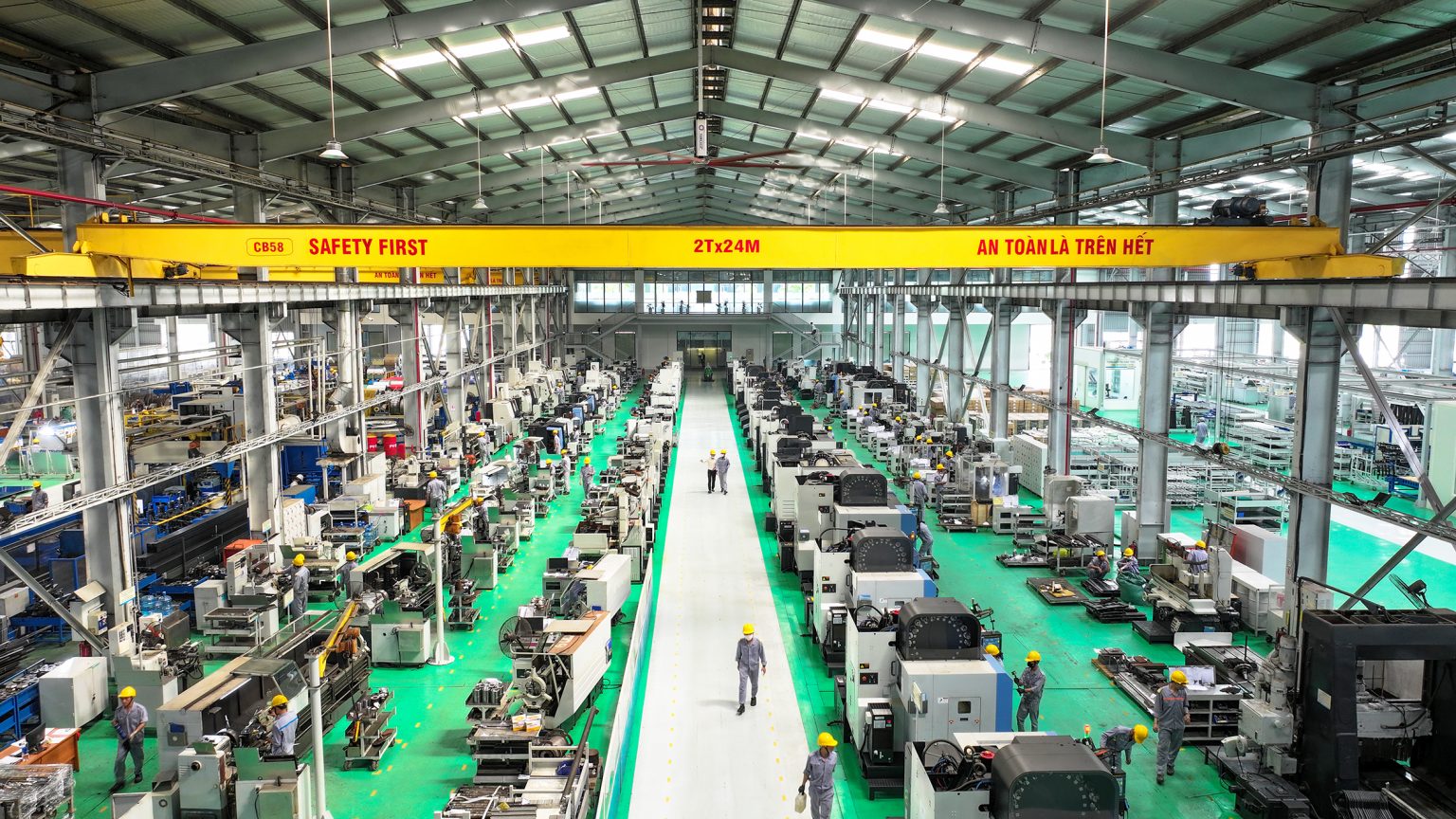Industrial Equipment
What is a Overhead Crane? Structure, Classification, and Installation
In modern industrial plants, overhead cranes play a crucial role in lifting and moving goods to ensure production runs smoothly. But what exactly is an overhead crane? How are they built, what types are available, and how are they installed? Let’s explore the basics with THACO INDUSTRIES.
What is an Overhead Crane?
An overhead crane (also known as a bridge crane) is equipment designed to lift and transport heavy loads safely and efficiently inside manufacturing plants and industrial facilities. The crane runs on a system of steel beams and uses hoists, winches, cables, and hooks to move goods. It can operate in two directions: lengthwise across the factory and side to side along the crane beam.

Overhead cranes are built to handle large capacities, ranging from 1 ton up to 500 tons. Powered by electric motors, they give businesses flexibility, convenience, and greater safety. Most models are operated remotely, allowing the crane operator to control movements with ease.
Structure of an Overhead Crane
A factory crane is made up of several key components:
- Main beam: The primary load-bearing part of the crane, typically made of square or L-shaped steel.
- End carriages: Rectangular steel structures (6–10 mm thick) with travel mechanisms and rubber shock absorbers at both ends to reduce impact during operation. Side beams connect to the main beam using bolts, flanges, or welds.
- Crane unit (trolley or hoist): The lifting device mounted on the main beam that moves along its length. Single-girder cranes usually use a hoist, while double-girder cranes use a trolley. Depending on the application, the system may use an electric wire rope hoist or an electric chain hoist.
- Control system: Includes switches, remote controllers, or automated systems that manage and monitor crane operations.

Other important parts include the electric winch, cables, and hooks, which work together to support lifting and movement tasks. Depending on the work environment, cranes can be customized with additional features for greater efficiency and safety.
Advantages of Overhead Cranes
Overhead cranes are essential for moving raw materials, machinery, and finished goods. Their benefits include:
- Higher efficiency: Able to lift and transport loads of up to hundreds of tons quickly and flexibly, saving time and boosting productivity.
- Reduced labor costs: Replaces manual lifting that would otherwise require many workers, lowering labor expenses.
- Improved safety: Equipped with modern systems such as sensors, automatic stops, and accident prevention features, cranes help ensure worker safety and steady production flow.
- Better use of space: Installed overhead or on factory ceilings, cranes free up valuable floor space for other operations.
- Cost-effective investment: Overhead cranes are relatively affordable, easy to install, maintain, or upgrade, and adaptable to changing production needs.
Types of Overhead Crane Beams

Overhead cranes can be classified by their structure and use:
Single-girder crane
This crane has one main beam and is designed for light to medium loads, from 500 kg to 10 tons. It has a simple design, takes up little space, and is easy to operate. Single-girder cranes are most suitable for small and medium-sized factories or workshops.
Double-girder crane
This crane has two main beams connected to side beams, making it capable of lifting heavier loads, from 5 tons to 100 tons. With a compact yet strong design and adjustable operating speed, it is commonly used in industries such as steel, cast iron, packaging, and thermal power.
The crane girder plays a critical role in determining both load capacity and safety. Choosing the right girder type and operating it correctly helps ensure safe and efficient performance.
Notes for Using Overhead Cranes
Safe and proper crane use is essential to protect both workers and property. Keep in mind the following guidelines:
Proper training and inspections are key to safe crane operations [/caption]
- Training and education: All crane operators must be trained in operating, safety regulations, and accident prevention measures.
- Regular inspections: Conduct periodic checks and maintenance to ensure reliable performance. Inspect cranes before each shift to identify and fix technical issues early.
- Load limits: Always stay within the crane’s maximum lifting capacity and never exceed the rated limits of cables or chains.
- Follow regulations: Adhere to all operating and safety rules set by the manufacturer or regulatory agencies, including the use of personal protective equipment (PPE).
- Control the work area: Always secure the crane’s operating area, ensuring no personnel or assets are within its movement zone during operation.
See more: How to safely operate an overhead crane?
Factors to Consider When Installing Overhead Cranes
Installing an overhead crane is a major task that must be handled with care to ensure safety and efficiency. Key factors to consider include:
Maximum load capacity
The crane’s lifting capacity depends on the maximum weight of the goods it will handle. This factor determines the structure, materials, and cost of the crane. The higher the required capacity, the higher the price. Providing accurate weight requirements helps ensure the crane is designed to handle the load safely.

Span (aperture)
Span is the distance between the two rails that support the crane. A larger span requires more steel for the main girder, which increases the overall cost.
Lifting height
This is the distance the crane hook travels from its lowest to highest point. It affects the type of hoist and chain used, as well as overall efficiency. Providing exact lifting height data allows the installer to select the right hoist and ensure smooth, effective operation.
Running track length
Track length is the distance the crane moves along the girder. It influences the design, the electrical system, and the overall installation cost. Accurate information ensures the installation unit designs a safe and efficient travel system.
How to Install an Overhead Crane

Installing a overhead crane is a complex job that requires expertise and strict safety compliance. Below are the basic steps in the installation process:
Step 1: Preparation and inspection
Paint all crane components to protect them from environmental impact. Carefully inspect each part to ensure quality and safety before installation.
Step 2: Install the side beams
Position the side beams according to technical drawings, ensuring accuracy and strong connections. Weld them securely to the main beam.
Step 3: Install additional parts
Add railings, subfloors, lifting bars, electrical systems, cables, and hooks. Make sure each component is installed correctly and operates safely.
Step 4: Lift the crane onto the rail
Use two cranes with sufficient capacity to lift the structure into place. Move and adjust the crane carefully to achieve balance and accuracy.
Step 5: Install the hoist and floor crane
Attach the hoist to the main beam following the manufacturer’s instructions. If equipped, install the floor crane as well.
Step 6: Install safety barriers and control system
Add safety barriers to protect operators. Then connect the control system, including cabinets, buttons, and remote controllers.
Step 7: Final check and testing
Inspect the entire system to confirm all components are installed and working properly. Conduct a test load to ensure stability and safe operation.
THACO INDUSTRIES – A Trusted Overhead Crane OEM and Installation Provider in Vietnam

THACO INDUSTRIES, a member of THACO Group, is proud to be a leading overhead crane OEM and installation provider. The corporation operates Vietnam’s largest mechanical complex, with closed-loop production lines imported from Australia, Switzerland, Japan, and Korea… This ensures products meet technical requirements with exceptional durability and precision.
All production stages are strictly controlled under international standards, including ISO 9001:2015 and ISO 14001:2015.
THACO INDUSTRIES provides a comprehensive service package covering consulting, design, processing, installation, operation transfer, and maintenance. With a team of 1,000 highly trained engineers and advanced design software, the corporation delivers tailored solutions for different industries and markets.
If you are looking for a reliable, competitively priced crane provider, THACO INDUSTRIES is the perfect choice. For fast support and expert advice, please contact our hotline: 0348620063


